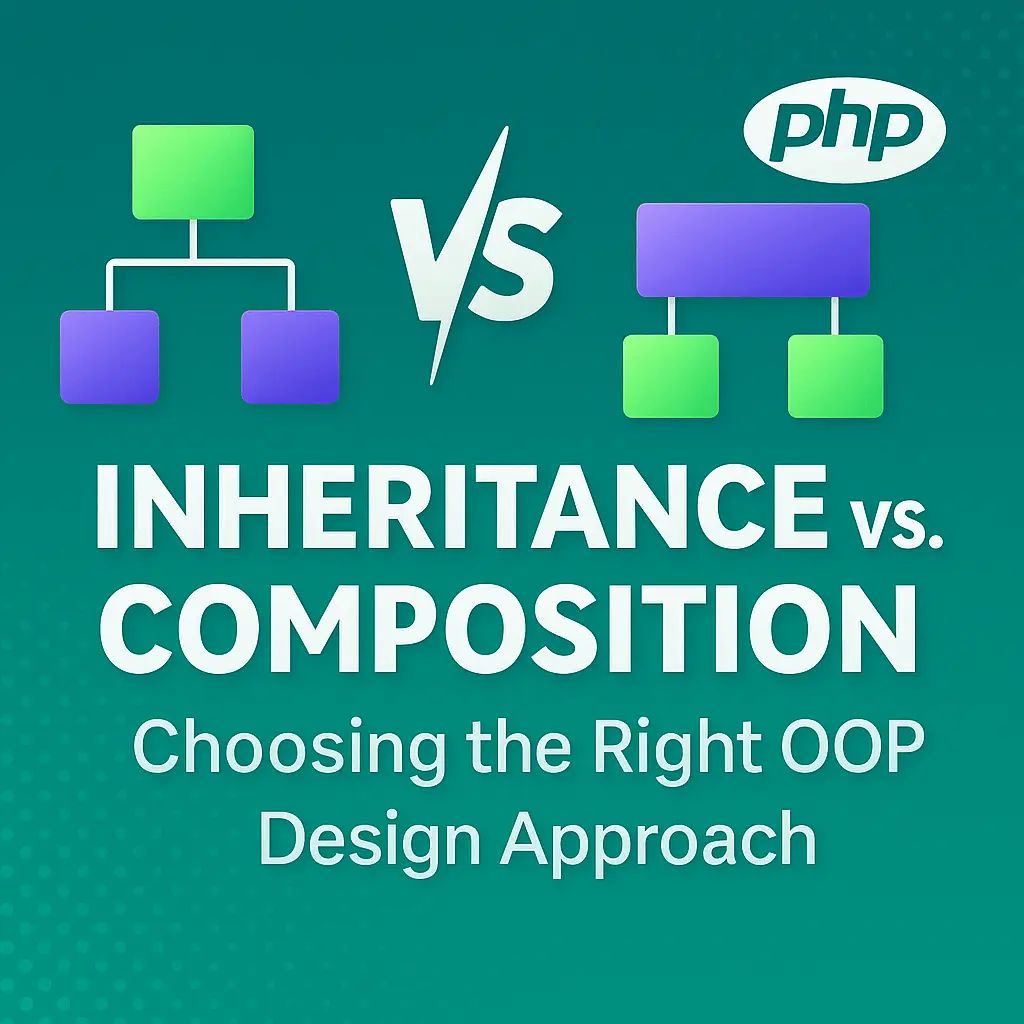In this article, we will explore the principles of inheritance and composition in PHP, their differences, advantages, and when to use each. We will provide practical code examples to illustrate these concepts.
Understanding Inheritance
Inheritance is a mechanism where one class (the child or subclass) inherits the properties and methods of another class (the parent or superclass). This allows for hierarchical classification and reusability of code. Inheritance promotes the idea of “is-a” relationships, where a subclass is a specialized version of the superclass.
Benefits of Inheritance
Code Reusability: Inheritance allows you to reuse code from the parent class, reducing redundancy.
Hierarchical Class Structure: It helps create a natural hierarchy of classes, making it easier to understand and manage.
Polymorphism: It supports polymorphism, allowing objects of different classes to be treated as objects of a common superclass.
Example: Inheritance in PHP
class Animal {
public $name;
public $age;
public function __construct($name, $age) {
$this->name = $name;
$this->age = $age;
}
public function eat() {
echo "$this->name is eating.\n";
}
public function sleep() {
echo "$this->name is sleeping.\n";
}
}
class Dog extends Animal {
public $breed;
public function __construct($name, $age, $breed) {
parent::__construct($name, $age);
$this->breed = $breed;
}
public function bark() {
echo "$this->name is barking.\n";
}
}
// Client code
$dog = new Dog("Buddy", 3, "Labrador");
$dog->eat(); // Inherited method
$dog->bark(); // Method specific to Dog class
In this example, the Dog class inherits properties and methods from the Animal class. The Dog class also has its own method bark, showcasing how inheritance allows adding specialized behavior.
Limitations of Inheritance
Tight Coupling: Inheritance creates a strong relationship between parent and child classes, leading to tight coupling.
Fragile Base Class Problem: Changes in the parent class can affect all child classes, potentially leading to unexpected issues.
Limited Flexibility: Inheritance is not well-suited for changing the behavior of a single instance at runtime.
Understanding Composition
Composition is an alternative to inheritance where a class is composed of one or more objects from other classes. It promotes the idea of “has-a” relationships, where a class contains instances of other classes. Composition is often preferred for creating complex behaviors and for greater flexibility.
Benefits of Composition
Loose Coupling: Composition creates a loosely coupled relationship between classes, making the system more modular and easier to maintain.
Reusability: By composing objects, you can reuse different components across multiple classes.
Flexibility: Composition allows changing behavior at runtime by composing different objects.
Example: Composition in PHP
class Engine {
public function start() {
echo "Engine started.\n";
}
public function stop() {
echo "Engine stopped.\n";
}
}
class Car {
private $engine;
public function __construct(Engine $engine) {
$this->engine = $engine;
}
public function startCar() {
$this->engine->start();
}
public function stopCar() {
$this->engine->stop();
}
}
// Client code
$engine = new Engine();
$car = new Car($engine);
$car->startCar();
$car->stopCar();
In this example, the Car class is composed of an Engine object. This demonstrates how composition allows the Car class to use the functionality of the Engine class without inheriting from it.
Composition Over Inheritance
The principle of “composition over inheritance” suggests using composition to achieve polymorphic behavior instead of relying solely on inheritance. This approach can lead to more flexible and maintainable code.
Example: Composition Over Inheritance
class FlyBehavior {
public function fly() {
echo "Flying high!\n";
}
}
class NoFlyBehavior {
public function fly() {
echo "Cannot fly.\n";
}
}
class Bird {
private $flyBehavior;
public function __construct($flyBehavior) {
$this->flyBehavior = $flyBehavior;
}
public function performFly() {
$this->flyBehavior->fly();
}
public function setFlyBehavior($flyBehavior) {
$this->flyBehavior = $flyBehavior;
}
}
// Client code
$bird = new Bird(new FlyBehavior());
$bird->performFly();
$bird->setFlyBehavior(new NoFlyBehavior());
$bird->performFly();
In this example, the Bird class can change its flying behavior at runtime by composing different FlyBehavior objects. This demonstrates the flexibility of composition.
Inheritance vs. Composition: When to Use Which?
Both inheritance and composition have their own use cases and advantages. Choosing between them depends on the specific requirements of your application and design goals.
When to Use Inheritance
Hierarchical Relationships: When there is a clear hierarchical relationship and an “is-a” relationship is appropriate.
Shared Behavior: When multiple classes share common behavior and attributes that can be abstracted into a superclass.
Polymorphism: When you need polymorphic behavior and the use of base classes makes sense.
When to Use Composition
Modularity and Reusability: When you want to create modular and reusable components that can be easily swapped or extended.
Flexibility: When you need the flexibility to change behavior at runtime or want to avoid tight coupling between classes.
Avoiding Inheritance Pitfalls: When you want to avoid the limitations of inheritance, such as the fragile base class problem.
Example: Combining Inheritance and Composition
In many cases, you can combine both inheritance and composition to leverage the strengths of both approaches.
class Device {
public function turnOn() {
echo "Device is on.\n";
}
public function turnOff() {
echo "Device is off.\n";
}
}
class Screen {
public function display($content) {
echo "Displaying: $content\n";
}
}
class SmartPhone extends Device {
private $screen;
public function __construct(Screen $screen) {
$this->screen = $screen;
}
public function showContent($content) {
$this->screen.display($content);
}
}
// Client code
$screen = new Screen();
$smartPhone = new SmartPhone($screen);
$smartPhone->turnOn();
$smartPhone->showContent("Hello, world!");
$smartPhone->turnOff();
In this example, the SmartPhone class inherits from the Device class (inheritance) and also contains a Screen object (composition). This allows SmartPhone to reuse the functionality of Device while also incorporating the behavior of Screen.
Conclusion
Understanding and effectively using inheritance and composition are crucial for writing robust, maintainable, and scalable PHP code. Inheritance allows for a clear hierarchical structure and code reuse, while composition provides flexibility and modularity. By understanding the strengths and limitations of each approach, you can make informed decisions about when to use inheritance, composition, or a combination of both. This will enable you to create more adaptable and resilient applications, adhering to the best practices of object-oriented design.






